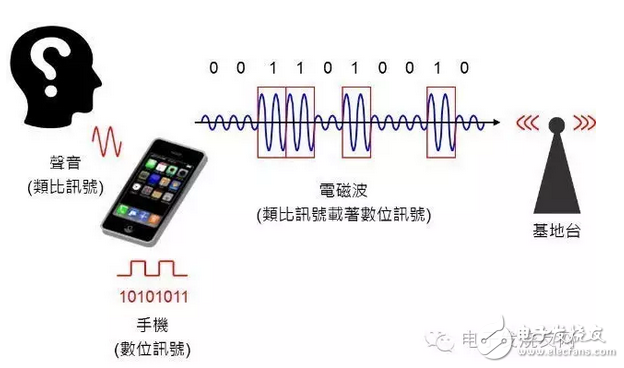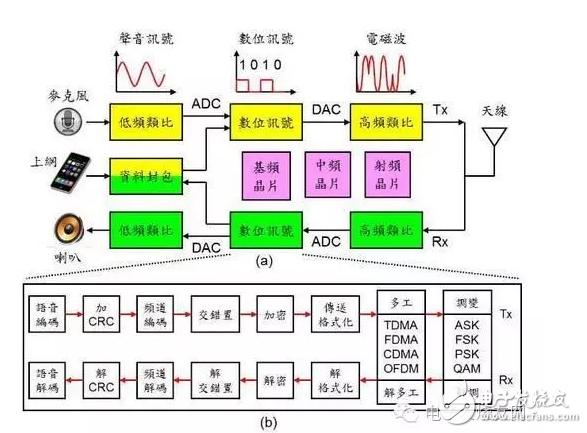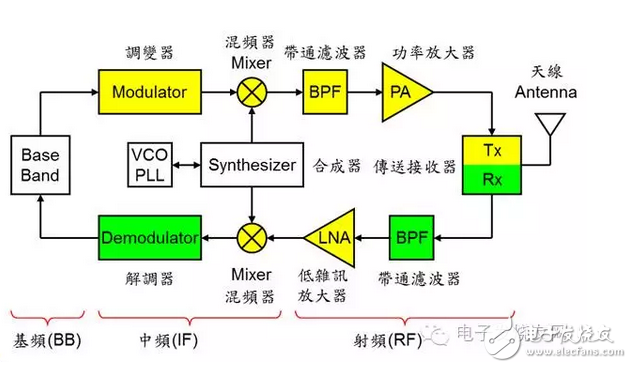The spectrum of wireless communication is limited, the distribution is very strict, and the electromagnetic waves of the same bandwidth can only be used once. In order to solve the problem of cumbersome and cumbersome, engineers have developed a lot of "modulation technology" and "multiplex technology" to increase the spectrum efficiency, so 3G, 4G, 5G technology of different communication era technology, then in our mobile phone, what components are responsible for handling these technologies for us? Modulation technology and multiplex technology First of all, we must understand that "modulation technology" and "multi-technology" are completely different things. Let us first look at what is the difference between them? Digital signal modulation technology (ASK, FSK, PSK, QAM): The analog electromagnetic waves are modulated into different waveforms to represent two different digital signals, 0 and 1. ASK uses amplitude to represent 0 and 1, FSK uses frequency to represent 0 and 1, PSK uses phase (waveform) to represent 0 and 1, QAM uses both amplitude magnitude and phase (waveform) to represent 0 and 1. Well, the digital signals 0 and 1 that each person's mobile phone antenna is going to transmit become electromagnetic waves of different waveforms. The problem is coming again. So many different waveforms of electromagnetic waves are thrown into the air, how to distinguish those that are yours (and What are you talking about, those are my (and I talked to)? Multiplex technology (TDMA, FDMA, CDMA, OFDM): Differentiate electromagnetic waves for different users. TDMA uses time to distinguish between yours and me. FDMA uses different frequencies to distinguish between yours and mine. CDMA uses different passwords (orthogonal spreading codes) to distinguish between yours and me. OFDM uses different positives. The subcarrier frequency is used to distinguish between yours and mine. It is worth noting that digital signal modulation technology or multiplex technology is performed together when digital signals (0 and 1) are processed and processed. Generally, multiplex technology is first used to perform digital signal modulation technology. (except for OFDM), so multiplex technology and modulation technology must be used at the same time. Digital modulation technology The current mobile phone belongs to "digital communication", that is, the voice of our speech (continuous analog signal), which is first converted into discontinuous 0 and 1 digital signals by the mobile phone, and then converted into electromagnetic waves by digital modulation (analog signal) Carrying the digital signal), and finally transmitting it from the antenna, the principle is as shown. Digital communication system architecture The architecture of the digital communication system is shown in the figure. The user may use a smartphone to make a voice call or access the Internet for data communication. We explain the following: Voice upload (speaking phone): After the sound is received by the microphone, it is a low-frequency analog signal, which is converted into a digital signal by a low-frequency analog-to-digital converter. The data is compressed by the “baseband chipâ€, and the cyclic repeat check code, channel code, and interlace are set. , encryption, formatting, and then multiplex, modulation and other digital signal processing. Next, it is converted into a high-frequency analog signal (electromagnetic wave) through an "IF chip" (IF), that is, a high-frequency digital analog converter (DAC); finally, electromagnetic waves of different time, frequency, and waveform are formed via a "radio frequency chip (RF)". It is transmitted by the antenna. Voice download (listening to the phone): The antenna receives the electromagnetic waves of different time, frequency and waveform, and obtains the high frequency analog signal (electromagnetic wave) after being processed by the "radio frequency chip (RF)", and then passes the "IF chip" (IF). A high frequency analog to digital converter (ADC) converts to a digital signal. Next, De-modulaTIon, De-mulTIplexing, De-formatTIng, De-ciphering, and de-interlacing are performed via "Basic Band (BB)". -inter-leaving), channel decoding, CRC, data decoding, etc., and finally converted to low frequency analog signals via low frequency digital analog converter (DAC) (Sound) is played back by the microphone. Data communication (online): Basically, data communication is digital signal regardless of uploading or downloading, so it can be directly processed into the baseband chip (BB). Other processes are similar to voice communication, and will not be repeated here. Note: The principle of communication is a lot of mathematics. Since mobile phones are things that we use every day, most people are curious about communication feelings and want to know more, but often go into the first class of the classroom to see It is a lot of complicated digital: Fourier Transform, Laplace Transform, Discrete, and immediately retreat. In order to simplify the complexity, it is easy for everyone to understand. The above is for digital communication systems. The introduction is just a gesture, and there will be a gap with the actual situation. It is recommended that those who are interested in further understanding can base on the above concepts to further understand the technical details. Wireless communication system architecture Based on the previous introduction, let's take a look at several important integrated circuits (ICs) in smartphones, including: basic frequency (BB), intermediate frequency (IF), and radio frequency (RF). Each part may have one to several integrated circuits (ICs), or it may be to package several integrated circuits (ICs) into one, called "System in a Package (SiP)", or to count The chips are integrated into one, called "System on a Chip (SoC)." Baseband chip: belongs to digital integrated circuit for compression/decompression of digital signals, channel encoding/decoding, interleaving/de-interlacing, encryption/decryption, formatting/deformatting, multiplex/demultiplexing, Modulation/demodulation, as well as management of communication protocols, control of input and output interfaces, etc., famous mobile phone baseband chip suppliers include: Qualcomm, Broadcom, Marvell, MediaTek and so on. Modulator: The digital signal processed by the baseband chip is converted into a high-frequency analog signal (electromagnetic wave), which can be transmitted very far. For those who want to know more about the communication principle, please refer to it here. Mixer: Mainly responsible for the frequency conversion work, converting the modulated high frequency analog signal (electromagnetic wave) into the required frequency to match the frequency range (wireless spectrum) of different communication systems. Synthesizer: Provides the operating frequency required for wireless communication electromagnetic waves and RF integrated circuits. It usually provides precise operation via "Phase Locked Loop (PLL) and "Voltage Controlled Oscillator"). frequency. Bandpass filter: Only the high frequency analog signal (electromagnetic wave) of a specific frequency range (band) is passed, and the unnecessary frequency range is filtered out to obtain the frequency range (band) we need. Power Amplifier: Before the high-frequency analog signal (electromagnetic wave) is transmitted, it must be amplified by a power amplifier (PA) to enhance the signal to be transmitted far enough. Transceiver: Transmitted (Tx:Transmitter) high frequency analog signal (electromagnetic wave) to the antenna, or received by the antenna (Rx: Receiver) high frequency analog signal (electromagnetic wave). Low noise amplifier: used when receiving signals. The high frequency analog signal (electromagnetic wave) received by the antenna is very weak. It must be amplified by a low noise amplifier (LNA) before it can be processed. Demodulator: used to receive signals, convert high frequency analog signals (electromagnetic waves) into digital signals, and then transmit them to the baseband chip (BB) for digital signal processing. Therefore, the principle of mobile phone uploading (talking phone) is: firstly, the digital audio signal is processed by the baseband chip (BB), and then converted into a high frequency analog signal by a modulator (Modulator), which is converted into a required by a mixer (Mixer). The frequency is obtained by a bandpass filter (BPF) to obtain a high frequency analog signal (electromagnetic wave) of a specific frequency range (band), which is enhanced by a power amplifier (PA) and finally transmitted by a transmission receiver (Tx) to the antenna output. On the contrary, the principle of mobile phone download (listening to the phone) is: firstly, the high frequency analog signal (electromagnetic wave) is transmitted by the antenna, received by the transmitting receiver (Rx), and then obtained by a band pass filter (BPF) to obtain a specific frequency range ( The high frequency analog signal of the frequency band is amplified by a low noise amplifier (LNA), converted into a desired frequency by a mixer (Mixer), converted into a digital voice signal by a demodulator (Demodulator), and finally The digital voice signal is processed by the baseband chip (BB). Communication related integrated circuit: fundamental frequency, intermediate frequency, radio frequency The back end of the wireless communication system described above uses a baseband chip to process digital signals, and the integrated circuit (IC) used in the front end can be roughly divided into "radio frequency chip" and "intermediate frequency chip". Large categories, using wafers of different materials: IF chip: Also known as "Analog baseband", the concept is "high-frequency digital analog converter (DAC)" and "high-frequency analog-to-digital converter (ADC)", including: Modulator, solution Demodulators, usually also IF amplifiers and intermediate frequency band filters (IF BPF), usually composed of CMOS components made of silicon wafers, possibly several integrated circuits, which may be integrated into An integrated circuit (IC). RF chip: Also known as "RF integrated circuit", it is a general term for all chips that process high-frequency wireless signals, usually including: transceiver, low noise amplifier (LNA), power amplifier (PA), bandpass filter (BPF), synthesis Synthesizers, Mixers, etc., usually composed of MESFETs made of gallium arsenide wafers, HEMT devices, or BiCMOS devices fabricated on germanium wafers, or CMOS devices fabricated from germanium wafers. A power amplifier made of gallium nitride (GaN) may be several integrated circuits, some of which may be integrated into one integrated circuit (IC). REMOTE CONTROL SOCKET
Programming Instructions
•Press any ON switch on the Remote Control for approximately 2 seconds and the Remote Socket(s) learn the code. The LED will stop flashing top confirm the codehas been accepted. remote switch,remote plug,remote control switch,remote power switch,remote control sockets NINGBO COWELL ELECTRONICS & TECHNOLOGY CO., LTD , https://www.cowellsocket.com


Important Safeguards
When using any electrical appliance, in order to reduce the risk of fire, electric shock and/or injury to persons, basic safety precautions should always be follow8d. including:
• The appliance is for household and indoor use only.
• Before plugging in. check that the voitage on the rating label is the same as the mains supply.
• To protect against electric shock, do not immerse any part of the product in water or other liquid.
• This socket is intended for use by competent adults only and children should be supervised at all times.
• Do not use the socket for other than its intended use.
• This socket can be used by children aged from 8 years arxl above and persons with reduced physical, sensory or mental capabilities or lack of experience and knowledge if they have been given supervision or instruction concerning use of the appliance in a safe way and understand the hazards involved. Children shall not p<ay with the appliance Cleaning and user maintenance shall M be made by children without supervision.
• Children of less than 3 years should be kept away unless continuously supervised.
Children from 3 years and less than 8 years shall only switch on/off the appliance provided that it has been placed or installed in its intended normal operating position and they have been supervision or instruction concerning use of the appliance in a safe way and understand the hazards involved. Children aged from 3 years and less than 8 years shall not plug in. regulate and clean the appliance or perform user maintenance.
• Don't use this socket in the immediate surroundings of a bath, a shower or a swimming pool.
• In case of malfunction, do not try to repair the socket yourself, it may result in a fire hazard or electric shock
Do Not Exceed Maximum a680W
Place the LR44 batteries provided into the compartment in the back of the Remote Control, please insert as sho*/m in the back of the compartment to ensure the polarity is correct.
• Plug the Remoce Socket$($)lnto the wall socket(s) and switch on the mams supply, the red LED will flash every second.
• If the LED is not flashing press & hold the manual ON/OFF button for 5 seconds until it Hashes
• Any number of Remote Sockets can be programmed to one Remote Control ON button to create multiple switching.
• To programme o<her Remote Sockets on different Remote Control ON buttons repeat the prevous steps
• If the mains supply is turned off the Remote Sockets v/ill lose their code and it wil be necessary to re-pcogramme.
Operation:
• Plug your appliance(s) into the Remote Socket(s)
• Press the programmed ON or OFF button on the Remote Control to control the Remote Socket.
♦ The Remote Sockets can also be operated manually using its ON/OFF Button Trouble shooting
If a Remote Socket does not react to the Remote Control please check the followng:
♦ Low battery in tbo Remote Control
• Distance too large between the remote control and the recerver (ensure the range distance is no more than 20 clear Metres) and free from obstacle that may reduce the distance.
• If programming has not been successful, tum the power off and back on then follow the programming steps above.
How to decode
• Press the manual ONX)FF button for 5 seconds until the red LED flashes once per
second to confirm de-coding is successful
♦ Press the ALL OFF switch on the Remote Control for more than 3 seconds, the LED
flashes once per second to confirm (decoding successful.
Voltage: 240V-/50HZ
Max power rating: 3680W max.
Remote frequency:
Remote range:
Battery Type:
433.92MHz
230 Metres
Button Cell 2x1.5V LR44 =
Please check with your local waste management service authority regarding regulations for the safe disposal of the batteries. The batteries should never be placed G municipal waste.
Use a battery d^posal facility if available
M
For eioctncal products sold within the European Community. At the end of the electrical products useful life, it should not be disposed of wth household waste. Please recycle faaMies exist. Check with your Local Authonty or retailer for recycling advice.
C€